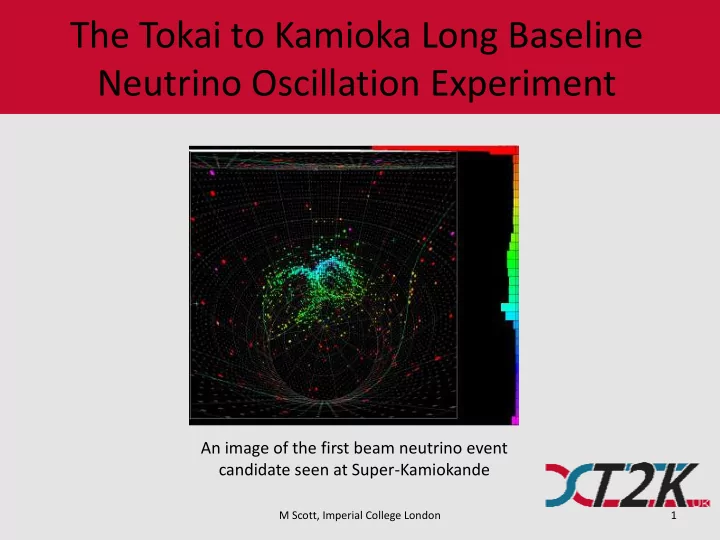

The Tokai to Kamioka Long Baseline Neutrino Oscillation Experiment An image of the first beam neutrino event candidate seen at Super-Kamiokande M Scott, Imperial College London 1
Overview • Theory of neutrino oscillations • Experiment outline and physics goals • The experiment – The neutrino beam – INGRID – ND280 – Super-Kamiokande • Test beam data analysis M Scott, Imperial College London 2
Neutrino Oscillations Weak eigenstates are not mass eigenstates but instead are a superposition of the three mass states, given by: 3 U i i i 1 where U α i is given by the Pontecorvo-Maki-Nakagawa- Sakata matrix: i 1 0 0 c 0 s e c s 0 13 13 12 12 U 0 c s 0 1 0 s c 0 i 23 23 12 12 i 0 s c s e 0 c 0 0 1 23 23 13 13 where c ij = cos Θ ij M Scott, Imperial College London 3
Neutrino Oscillations - 2 Oscillation and survival probabilities for specific flavour states can be calculated: Survival 2 1 . 27 m L 4 2 2 23 P ( ) 1 cos sin 2 sin 13 23 E ν e appearance 2 1 . 27 m L 2 2 2 13 P ( ) sin 2 sin sin e 13 23 E where L is the distance the neutrino has travelled in km, E ν is the neutrino energy in GeV, and Δ m 2 i – m 2 ij = m 2 j . M Scott, Imperial College London 4
Experiment outline and physics goals • 295km baseline neutrino beam experiment • A suite of near detectors and a 50kton water Cherenkov detector. • Physics goals: – Discovery of ν µ ν e oscillation – Precision measurements of oscillation parameters in ν µ disappearance – Search for a sterile component of ν µ M Scott, Imperial College London 5
The T2K experiment – The neutrino beam • 30GeV protons collide with a graphite target • Magnetic horns focus mesons • Mesons undergo 2-body decay, producing neutrinos • Has an overall power of 0.75MW M Scott, Imperial College London 6
The Interactive Neutrino GRID • Designed to measure the beam direction to 1mrad • 16 identical modules • 10 x 10m 2 cross • 11 scintillator layers interspersed with 9 iron plates. M. Otani et al . Nuclear Science Symposium Conference Record, 2008. Pages 2930 - 2933, Oct. 2008. M Scott, Imperial College London 7
The ND280 detector • Necessary to characterise the neutrino beam • Three regions: – The π 0 detector (P0D) – The tracking detectors – The electromagnetic calorimeter (ECAL) • Scintillator bars used throughout read by multi-pixel photon counters (MPPCs). M Scott, Imperial College London 8
Super-Kamiokande • 50kton water Cherenkov detector • 1km underground, equivalent to 2.7km of water. • Can separate muons from electrons with a rejection factor of about 100 • Reconstructs particle ID, energy and direction along with the interaction vertex • Accepts events whose vertices > 2m from the sides of the tank giving a fiducial volume of 22.5ktons M Scott, Imperial College London 9
First T2K neutrino event at SK! 1st + 2nd ring Invariant mass: 133.8 MeV/c 2 Momentum: 148.3 MeV/c M Scott, Imperial College London 10
Test beam data analysis • T2K construction is nearing completion and the first beam event has been seen in SK. • The Downstream ECAL was used to collect data from a test beam at CERN last year • A number of calibration constants are being calculated with the aim of starting a data production run in about 1 month. M Scott, Imperial College London 11
Backup slides Neutrino energy spectrum for 1, 2 and 3 degrees off axis M Scott, Imperial College London 12
EFV at SK • Work by G. Kogan, S. Dipper M Scott, Imperial College London 13
Light attenuation along scintillator bars • Particles deposit energy in the bar • Scintillation is collected by wavelength shifting fibres • Carried to MPPCs to be collected and readout Work done by M. George M Scott, Imperial College London 14 (QMUL) and G. Davies (Lancs.)
Charge injection calibration • Measuring the ratio of the charge output from the MPPC readout electronics to that input from the MPPCs. • This is fitted with a cubic polynomial, allowing the input charge to be calculated from the measured output Work done by A. Waldron M Scott, Imperial College London 15 (Oxford)
Recommend
More recommend